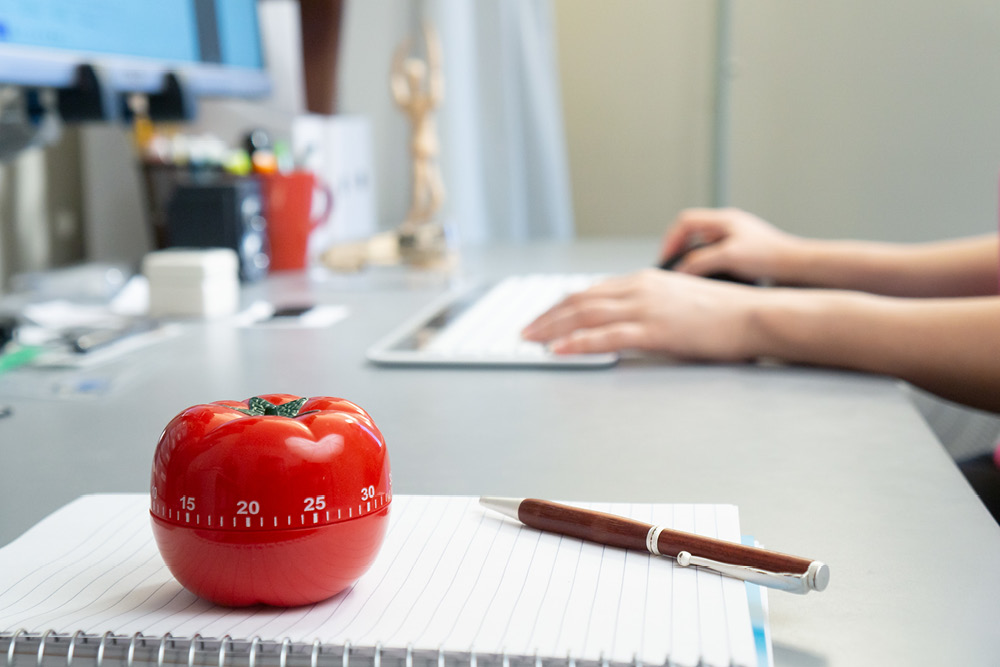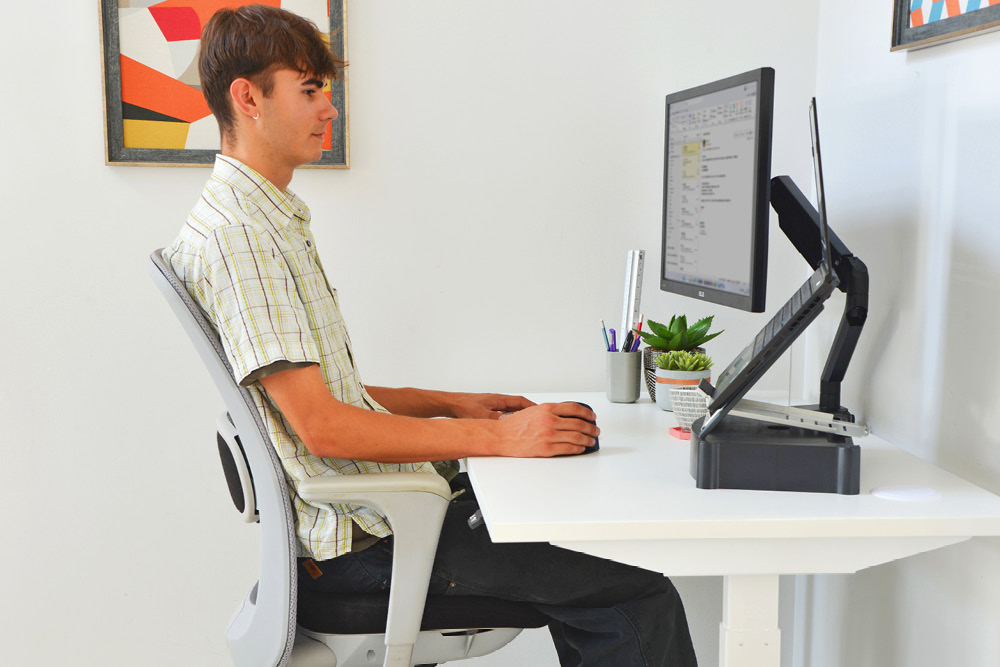![]()
Let's start by quickly defining what they are:
- The Pomodoro Technique is a time management method that offers a structured approach to productivity with fixed work and break intervals, aiming for deep focus and routine.
- Microbreaks at work are flexible, very short pauses to quickly refresh physical and mental wellbeing.
In this blog, I’ll make a comparison between the Pomodoro Technique vs. microbreaks for productivity, and look at the pros and cons of each.

To help you decide which approach is right for you, I’ve also spoken to people who love or loathe each technique.
So what’s your approach going to be for tackling your to-do list and protecting your wellbeing?
Comparing the Pomodoro Technique and microbreaks approach
Let’s look in more detail at the two time management methods and how they work:
Pomodoro Technique

‘Pomodoro’ is the Italian word for tomato. You’re not alone if you’re wondering what this has to do with managing your time…
So, why is it called the Pomodoro Technique?
The Pomodoro Technique name comes from a simple tomato-shaped kitchen timer. Its inventor, Italian student Francesco Cirillo, was struggling with procrastination and lack of focus in his studies at the Sapienza Università in Rome in the 1980s, and on a whim decided to use a tomato timer to time his work intervals.
You can use any kind of timer, by the way!

The objective is to make the task at hand seem more achievable by breaking it down into manageable chunks. The specific working time helps you to be disciplined, while having a break to look forward to.
How to use the Pomodoro Technique at work

Here's how to get started with the Pomodoro Technique:
- Choose a task.
- Set a timer to work for 25 minutes. This could be a physical timer, like a kitchen timer with an alarm, or a digital timer such as an app. Aim to focus fully on your specific task, and turn off other distractions.
- Take a 5 minute break. Your brain gets a breather.
- Set the timer to work for another 25 minutes. Each chunk of working time like this is known as a pomodoro.
- Take another 5 minute break.
- Work for another 25 minutes.
- Take another 5 minute break.
- Work for another 25 minutes.
- After four pomodori, take a longer break (typically 20 to 30 minutes) . A walking break would be perfect here, to let your mind reset and give your body a proper stretch.
You can customise these timings. Obviously, it’s up to you how many minutes will suit your working style.
The benefits of the Pomodoro Technique

If you are struggling with time management and concentration, the Pomodoro technique might be the right solution, as it offers a variety of advantages:
- It can help improve your focus and concentration.
- It can help reduce stress and procrastination (delaying or postponing doing something you need to do) by making large tasks feel more manageable.
- The regular breaks can help decrease mental fatigue and burnout.
- Regular breaks are good for your physical health too. The breaks can be part of your strategy to prevent headaches at work.
- It can help you sit less. Moving away from your desk during the breaks and active working is highly recommended by wellbeing at work experts.
- It could boost your productivity. You’ve zoned in on a task to give it your all and the job gets done.
- You could think of new ideas and perspectives during the breaks.
- You could feel a sense of accomplishment for the focus you have managed.
What should you do during your Pomodoro break?

Try to have a digital break with no technology. You could:
- Go and refill your glass of water. Try to drink 1.5 to 2.5 litres of fluid daily. Staying hydrated is important for your overall health and your back, as we discuss in our blog "The 5 Best Free Things You Can Do for Your Back."
- Prep your lunch for later. Optimise your breaks by tackling small household tasks you'd have to do anyway, such as prepping lunch. This works perfectly when you're working from home.
- Chat to a colleague.
- Get a breath of fresh air outside.
- Take a bathroom break.
- Stretch your body or do some yoga, pilates or dance moves.
- Do deep breathing exercises.
- Water your plants or tend to your window box.
- Make a short phone call while pacing around.
- Looking away from your computer screen is also brilliant for your eye health.

Find a good online Pomodoro timer
If you're ready to start, a good timer is all you need. Here are some recommendations if you'd like to use an online timer:
- Pomofocus is very simple to use and you can choose your alarm sounds and background sounds. It offers templates and visual reports.
- Focus To-Do features both a Pomodoro timer and help with tracking and managing tasks.
- Cat lover? Pomodorokitty has a calming, gentle interface. It simply asks, ‘What would you like to accomplish?’

Some Pomodoro Technique users recommend having an app on a smartwatch (for example, Tomito on an Apple Watch) rather than a phone. Then your chances of getting distracted by your phone are reduced, which is a key objective of the Pomodoro Technique.
Microbreaks

A microbreak at work is a very short break, and the idea is to take these frequently throughout your working day. They’re not just for popping to the loo, they’re for refreshing both your body and your brain too, to help you do your best work.
Microbreaks are a key element of the active working approach, and are the ideal opportunity to move more often.

During your microbreak, you could move around your workplace or home, get a drink, put some washing in, have a chat with a colleague around the watercooler, sort your recycling, or play with a pet. It’s your choice of course.
Microbreaks can also be standing up for a few seconds then sitting down or exercises at the workstation, and shaking your hands out. Mix these up with small breaks away from sitting at the workstation.
“If you are taking lots of short breaks, do use them to move. Don't just sit there and go on your phone” Katharine Metters from Posturite urges. “A physical break will benefit you mentally as well.”
But how long should microbreaks at work be?
- A microbreak is typically between 30 seconds and two minutes.
- Stanford University recommends taking a microbreak every 20 minutes.
Aim to take medium and long breaks as well as microbreaks. Frequent microbreaks are not a replacement for longer periods of downtime.
The benefits of taking microbreaks

The health and productivity benefits of taking microbreaks include:
- Protecting your musculoskeletal health. Many aches and pains creep up when we sit down for too long without moving. The NHS states that sitting down too much can be a risk to your health and taking microbreaks can help prevent back pain in the workplace.
- Giving your brain a chance to reset and reenergise. Focusing too long on one thing can actually drain energy. Harvard Business Review reports that “excessive focus exhausts the focus circuits in your brain.”
- Giving your eyes a break, if your work involves looking at a computer screen.
- Reducing fatigue: recent research by West University of Timoșoara and reported by The British Psychological Society showed that workers who took microbreaks showed a small but significant reduction in fatigue.
- Disrupting poor postures.

Take a look at the scientific evidence for the benefits of physical activity breaks during your workday in the webinar Move more at work: treat your body and brain with Dr Charlotte Edwards:
For all these reasons, Posturite’s workstation assessors recommend microbreaks to clients – they do make sense for optimum physical and mental health, and productive working.
Do managers encourage employees to take regular breaks?
They should, and many do. With microbreaks enhancing your physical and mental wellbeing, you’re likely to be more productive, so it’s in an organisation’s self-interest to want you to perform at your best.
The UK’s government’s guidance from the Health and Safety Executive on Working safely with display screen equipment recommends ‘taking short breaks often’ and that ‘5 to 10 minutes every hour is better than 20 minutes every 2 hours’.
A Pomodoro Technique and microbreaks comparison table
Here’s a quick reference table for the Pomodoro Technique vs. microbreaks:
| Feature | Pomodoro Technique | Microbreaks |
|---|---|---|
| Structure | Highly structured, fixed work/break intervals. | Flexible, informal, taken as needed. |
| Duration | Work: 25 mins; Short break: 5 mins; Long break: 15-30 mins. | 30 seconds to up to 2 minutes. |
| Purpose | Combat procrastination, improve deep focus, manage time. | Alleviate and prevent fatigue (mental and physical), quick refresh. Prevent pain from being too sedentary. |
| Pacing | Specifies a rhythm for work and rest. | Breaks can occur more randomly or frequently. |
| Primary Focus | Time management, focused work sprints. | Physical wellbeing, quick mental resets. |
| Disruption | Breaks are integral to the work cycle. | Minimally disruptive, often unnoticeable to others. |
| Example | 25 min work, 5 min stretch, 25 min work, etc. | Look away from screen for 30 seconds, stand up and stretch for 1 minute. |
As you can see, the objectives of taking microbreaks are quite different to those for the Pomodoro method. The primary focus of microbreaks is on wellbeing, whereas it’s on ‘getting the job done’ for the Pomodoro Technique.
Should you use Pomodoro or microbreaks while working?

It’s very easy (and free) to try out both of these time management techniques at work, so see what works for you.
Consider the following aspects:
What type of work do you do? This will be a big factor in your choice.
- If you have lengthy, intensive pieces of work and projects to do, then Pomodoro could be ideal for helping you to get started and focus on those.
- Whereas if your work involves lots of short transactions and short tasks, you might not need the task-breaking-down aspects of Pomodoro.

Do you ever struggle with back or neck pain at work?
- Both methods will encourage you to take breaks and reduce the time that you’re sedentary.
Do you like systems and routine?
- If the answer is yes, you could find the discipline of Pomodoro enjoyable.
- Whereas if you object to rigid rules, you are likely to prefer microbreaks.
You could even combine the two – taking active microbreaks during your pomodoro breaks.
Trying out the Pomodoro Technique; love it or hate it?

As promised at the beginning of this blog, I’ll be sharing some real-world experiences. I asked people in a variety of roles whether they prefer microbreaks or the Pomodoro Technique. Here's what they had to say.
Pomodoro doesn’t work for me
“It's such an individual thing - and I hate it! The Pomodoro Technique is not for me. I personally find it too prescriptive. And I don't think I can get to deep thought and get tasks complete in just 25 minutes. But it’s great to be exposed to different approaches to productivity and try them out. I take microbreaks and find these work well for me to have those frequent physical and mental resets.”
Katharine Metters, Lead Consultant in Ergonomics at Posturite
“No, the Pomodoro method is not for me. I didn't like Pomodoro - I found clock-watching added stress. I do time-blocking for work that takes chunks of time but isn’t too urgent, and then incorporate ‘Eat that Frog’ for urgent tasks.”
Christina Clark, Key Account Support Executive
‘Eat that Frog’ is a time and priority management approach where you steel yourself to tackle the most difficult or urgent task first. It’s often the task you’re dreading, and then you feel great satisfaction that it’s done.

“I've given Pomodoro a go, but found it's not for me. I found that stopping what I’m doing because a timer tells me to, rather than when I’ve reached a natural pause, actually breaks my concentration. It doesn’t really fit with the type of work I do as it’s quite varied - some things are quick two-minute jobs, and others need longer stretches of focus. For me it just felt a bit too restrictive. I prefer a mix of approaches that let me prioritise (Eat That Frog), stay organised (Getting Things Done), and use flexible scheduling (Time Blocking). This combo helps me adapt my day to the tasks I’ve got, and keeps things flexible.”
Annelese Haines, Head of Sales Administration
The Pomodoro Technique enthusiasts

“The Pomodoro method works for me. Watching the stopwatch really keeps me accountable. Not sure why, but it works! The Pomodoro Technique really helps me to stay focused and avoid getting distracted by other tasks. I’ll tell myself ‘I’m working on this for an hour, then I’ll check my emails.”
Sophie Hopkins, E-Procurement Coordinator
If you want to find out what a major distractor constant emails and messages can be and possible solutions, check out the webinar ‘How to achieve real productivity: for wellbeing and success’.
“I like the fact that you are just committing to work for the length of the timer and this is enough to get started. I use an online timer or the one in my Google Assistant. I tend to work on task for that time and then switch to an easier task. Clients experiment with the length of the time and the breaks, sometimes preferring a longer time to focus.”
Chris Stribblehill, Workplace Strategies Coach
“I can accomplish more in less time with Pomodoro. It minimises distractions.”
Dr. Chusin Mateechaipong, Business Workshop Facilitator

Is the Pomodoro technique helpful if you have ADHD?
It can be, yes. On an ADHD UK forum, a contributor said that he likes to use the Pomodoro method for:
“Getting started on big tasks. When the timer goes off, I don’t have to stop – it’s just a thing for me to get started.”
Potentially, Pomodoro can encourage regular breaks to help you avoid burnout and overwhelm.
However, everyone with a neurodiversity such as ADHD is different, and the technique will work very well for some and not at all for others. Likewise, microbreaks may not be a hit if you have ADHD. “I do an hour’s worth of work in 20 minutes and then need a longer break. I’d call it a macrobreak!” says Vikki Greer, about her workplace adjustments for ADHD.
Take the advice: take a break

Whether it’s microbreaks or the Pomodoro Technique breaks during working hours, short breaks are vital for mental and physical health, at home and in the office. Aim to include regular or random short breaks as part of an Active Working strategy.
“It’s a balance” says ergonomist Katharine Metters, “because there should be both physical wellbeing and output goals for any of these techniques. You’ve got to get your work done, and you want to feel physically comfortable and look after your health. A break should be a win-win for you personally - and for your work.”
A short, active break is:
- Revitalising physically
- Rejuvenating mentally
- Brilliant for helping to prevent aches and pains
The human mind and body are incredible, but we've got to keep up the ongoing maintenance so they can continue to be incredible.
Read next:












